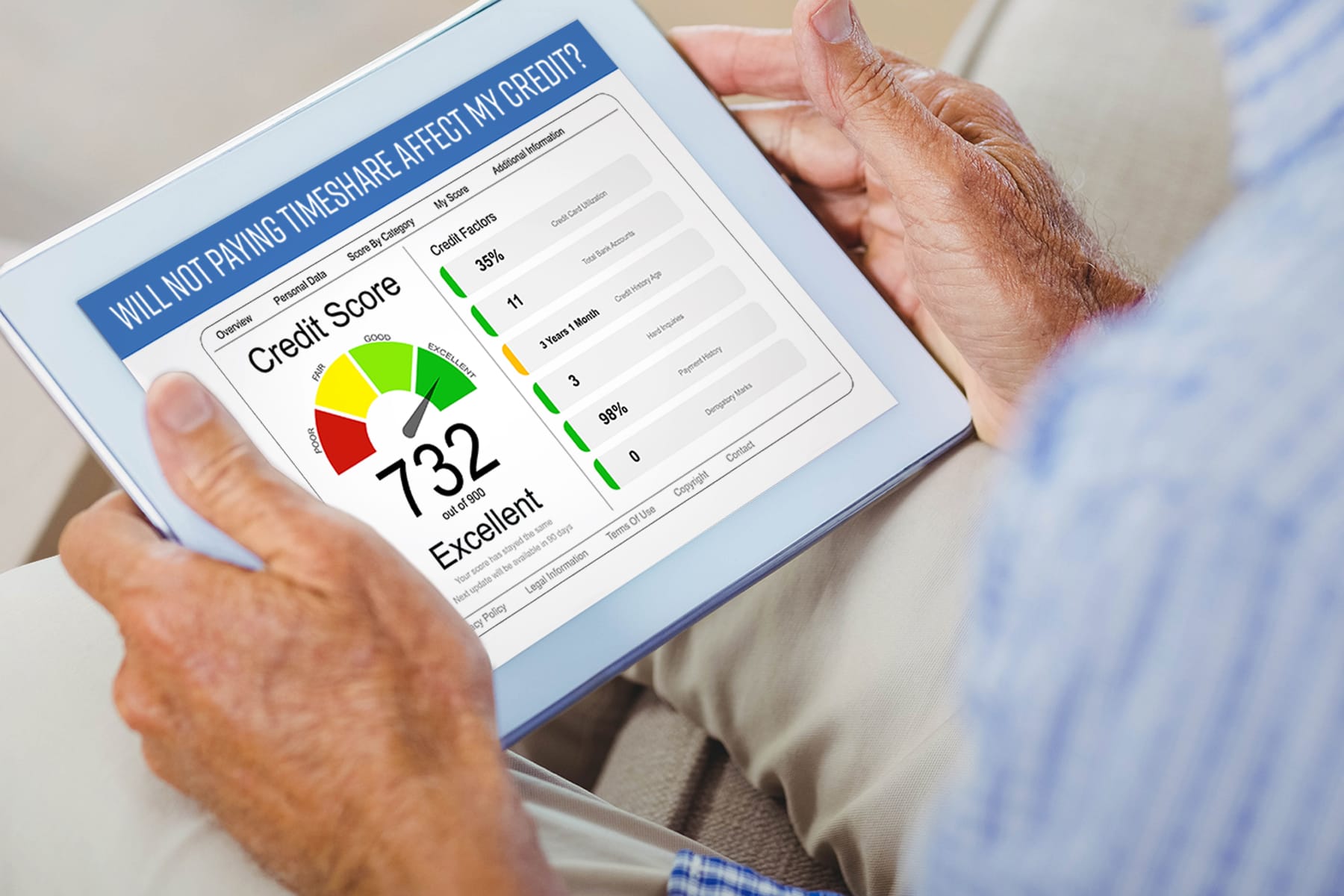Home>Finance>How To Remove Derogatory Mark From Credit Report


Finance
How To Remove Derogatory Mark From Credit Report
Published: October 20, 2023
Learn how to remove derogatory marks from your credit report and improve your financial standing. Take control of your finances with our helpful tips and strategies.
(Many of the links in this article redirect to a specific reviewed product. Your purchase of these products through affiliate links helps to generate commission for LiveWell, at no extra cost. Learn more)
Table of Contents
- Introduction
- Understanding Derogatory Marks on Credit Reports
- Importance of Removing Derogatory Marks
- Steps to Remove Derogatory Marks from Credit Reports
- Obtain a Copy of Your Credit Report
- Review the Derogatory Marks
- Dispute Inaccurate Information
- Provide Supporting Evidence
- Follow Up with Credit Bureaus
- Seek Legal Assistance if Necessary
- Tips for Preventing Future Derogatory Marks
- Conclusion
Introduction
Having a good credit score is essential for financial stability and achieving your goals. Unfortunately, life sometimes throws unexpected curveballs that can lead to derogatory marks on your credit report. These marks can have a negative impact on your creditworthiness, making it difficult to obtain loans or secure favorable interest rates.
Derogatory marks on a credit report refer to negative information that creditors report to credit bureaus. These marks can include late payments, collections, bankruptcies, foreclosures, or even judgments against you. Each derogatory mark can stay on your credit report for several years, dragging down your credit score and hindering your financial prospects.
Fortunately, it is possible to remove derogatory marks from your credit report. By taking action and following a few key steps, you can improve your credit standing and regain control of your financial future. In this comprehensive guide, we will outline the importance of removing derogatory marks, as well as provide a step-by-step process to help you successfully remove them from your credit report.
Understanding Derogatory Marks on Credit Reports
Before diving into the process of removing derogatory marks from your credit report, it’s important to understand what these marks are and how they can affect your financial standing. Derogatory marks are negative entries that appear on your credit report and can significantly impact your credit score. These marks serve as a red flag to potential lenders, indicating a higher level of risk associated with lending to you.
Derogatory marks can take various forms, such as late payments, delinquent accounts, charge-offs, collections, repossessions, foreclosures, or even bankruptcies. Each of these marks can have different implications and remain on your credit report for a specific period, typically ranging from 7 to 10 years. During this time, they can have a lasting impact on your ability to secure credit, obtain favorable interest rates, and even impact your housing and employment opportunities.
Late payments are one of the most common types of derogatory marks. When you fail to make payments on time, creditors can report those late payments to the credit bureaus, resulting in a negative mark on your credit report. Delinquent accounts occur when you consistently fail to make payments, and the account is past the due date. These marks are seen as a sign of financial instability and can negatively impact your creditworthiness.
Charge-offs and collections occur when you fail to pay off a significant amount of debt, and the creditor writes off the debt as a loss or sells it to a collection agency. These marks indicate that you have not fulfilled your financial obligations and can have a severe impact on your credit score.
Foreclosures and bankruptcies are some of the most damaging derogatory marks. A foreclosure occurs when you fail to make mortgage payments, leading to the lender repossessing the property. This mark can make it challenging to qualify for future mortgages. Bankruptcies, on the other hand, signify a complete inability to repay debts and can stay on your credit report for up to 10 years.
Understanding the different types of derogatory marks is crucial because each mark requires a specific approach for removal. Additionally, being aware of what potential lenders see on your credit report will empower you to take the necessary steps to improve your creditworthiness and financial standing.
Importance of Removing Derogatory Marks
Removing derogatory marks from your credit report is crucial for several reasons. Firstly, derogatory marks have a significant negative impact on your credit score. Your credit score is a numerical representation of your creditworthiness, and it plays a vital role in your financial life. Lenders, landlords, insurance companies, and even potential employers often look at your credit report to evaluate your level of responsibility and risk.
Derogatory marks can lower your credit score significantly and make it difficult for you to obtain credit in the future. This can result in higher interest rates, limited access to loans, or even outright denials for credit applications. By removing derogatory marks, you can improve your credit score and enhance your financial prospects.
Additionally, removing derogatory marks can also positively impact your overall financial well-being. A higher credit score allows you to qualify for lower interest rates on loans, credit cards, and mortgages. This means you’ll save money on interest payments, which can add up to thousands of dollars over time.
Furthermore, removing derogatory marks can improve your chances of securing better housing or rental opportunities. Landlords often conduct credit checks to assess your financial responsibility. If your credit report shows derogatory marks, it can be harder to rent an apartment or house, leaving you with limited options and potentially higher rental costs.
Another important aspect is the potential impact on your employment opportunities. Some employers may request permission to check your credit report as part of their hiring process. Derogatory marks on your report can give the impression of financial instability, which may negatively affect your chances of being hired or considered for certain positions.
Overall, removing derogatory marks is crucial for improving your credit score, accessing better financial opportunities, and enhancing your overall financial well-being. By taking the necessary steps to dispute and remove these marks, you can regain control of your financial future and open doors to better financial prospects.
Steps to Remove Derogatory Marks from Credit Reports
Removing derogatory marks from your credit report requires proactive steps and persistence. Here is a step-by-step process to guide you through the removal process:
- Obtain a Copy of Your Credit Report: Start by requesting a free copy of your credit report from each of the three major credit bureaus – Experian, TransUnion, and Equifax. You are entitled to one free report from each bureau annually.
- Review the Derogatory Marks: Thoroughly examine your credit report for any derogatory marks that need to be addressed. Take note of the type of mark, the creditor reporting it, and the date of the occurrence.
- Dispute Inaccurate Information: If you find any inaccurate or incorrect derogatory marks, you can submit a dispute to the credit bureaus. Provide specific details about why the mark is incorrect and include any supporting documentation.
- Provide Supporting Evidence: When disputing derogatory marks, gather evidence to support your claim. This could include payment receipts, loan agreements, or any other relevant documentation that proves the inaccuracy or outdated nature of the mark.
- Follow Up with Credit Bureaus: Stay proactive by following up with the credit bureaus on the status of your dispute. The bureaus are required to investigate your dispute within 30 days, and if they find it to be inaccurate, they must remove or correct the derogatory mark.
- Seek Legal Assistance if Necessary: In some cases, the removal process may require legal intervention. If you encounter obstacles or if your dispute is unsuccessful, consider consulting with a consumer attorney who specializes in credit reporting and dispute resolution.
Remember, the process of removing derogatory marks may take time and persistence. It is important to stay organized, keep records of all communications, and be patient throughout the process. Be diligent in following up with the credit bureaus and providing any additional information they may require. By taking these steps, you can increase your chances of successfully removing derogatory marks from your credit report and improving your overall creditworthiness.
Obtain a Copy of Your Credit Report
The first step in the process of removing derogatory marks from your credit report is to obtain a copy of your credit report. You are entitled to one free credit report every 12 months from each of the three major credit bureaus – Experian, TransUnion, and Equifax. By requesting and reviewing your credit reports, you can gain a comprehensive understanding of your financial standing and identify any derogatory marks that need to be addressed.
To obtain your free credit reports, you can visit the official website of AnnualCreditReport.com, which is authorized by the federal government. Alternatively, you can contact each credit bureau individually and request a copy of your credit report. It’s important to note that while the credit reports are free, there may be a nominal fee if you want to access your credit score along with the report.
Once you have obtained your credit reports, carefully review them for accuracy and identify any derogatory marks that are negatively impacting your creditworthiness. Make sure to pay attention to details such as late payments, collections, charge-offs, repossessions, foreclosures, or bankruptcies. Take note of the date, type, and the creditor associated with each derogatory mark as this information will be vital when disputing the marks.
If you notice any errors or inconsistencies, it is important to address them promptly. Errors and inaccuracies can occur, so it’s essential to correct them to ensure an accurate reflection of your credit history. Disputing these erroneous marks can lead to their removal and subsequent improvement in your credit score.
By obtaining a copy of your credit report, you are taking the first step towards understanding your financial standing and identifying derogatory marks that need to be addressed. This knowledge will empower you to take the necessary actions to remove these marks and improve your creditworthiness and overall financial health.
Review the Derogatory Marks
After obtaining a copy of your credit report, the next step in removing derogatory marks is to carefully review and assess each mark. Take the time to thoroughly examine your credit report and make note of any derogatory marks that are impacting your creditworthiness.
As you review the derogatory marks, pay attention to the type of mark, the creditor reporting it, and the dates associated with each mark. This information will be crucial when addressing these marks and disputing inaccurate or outdated information.
Identify the specific derogatory marks on your credit report, such as late payments, collections, charge-offs, repossessions, foreclosures, or bankruptcies. Understanding the nature and severity of each mark will help you prioritize which ones to address first.
It’s essential to cross-reference the derogatory marks with your own records or statements. Sometimes, errors or discrepancies can occur, resulting in inaccurate reporting. Compare the information on your credit report with any documentation or records you have to ensure its accuracy.
Additionally, if you notice any duplications, incorrect dates, or marks that should have been removed after a specific time period, make a note of them. These errors can have a significant impact on your credit score, so it’s crucial to address them during the removal process.
Keep in mind that derogatory marks have different consequences and timeframes. For example, late payments and collections may remain on your credit report for seven years, while bankruptcies can persist for up to ten years. Understanding the timeline associated with each mark will help you gauge the impact and urgency of removing them.
By reviewing and fully understanding the derogatory marks on your credit report, you are equipping yourself with the knowledge needed to address each mark effectively. This evaluation will allow you to prioritize your efforts and take targeted action to remove the derogatory marks, ultimately improving your creditworthiness and financial standing.
Dispute Inaccurate Information
Once you have reviewed the derogatory marks on your credit report and identified any inaccuracies, it is essential to take prompt action by disputing the incorrect information. Disputing inaccurate derogatory marks is a crucial step in the process of removing them from your credit report and improving your creditworthiness.
To initiate a dispute, you can contact the credit bureau that generated the credit report showing the inaccurate information. You can typically file a dispute online, through mail, or via phone, depending on the credit bureau’s preferred method.
When disputing the inaccurate information, clearly state the reason for the dispute and provide any supporting documentation you have that proves the inaccuracy. For example, if you have evidence of a payment made on time or proof that a debt has been settled, include copies of those documents along with your dispute.
Be specific and detailed in your explanation, highlighting the incorrect information and explaining why it is inaccurate. Clearly state the discrepancies and provide any relevant facts or circumstances that support your claim.
It is important to keep copies of all your correspondence and documentation related to the dispute. This will serve as evidence later on if you need to escalate the dispute or provide further information.
Once the credit bureau receives your dispute, they are required by law to investigate your claim within 30 days. During this time, they will contact the creditor who reported the derogatory mark and ask for verification of the information. If the creditor cannot provide sufficient evidence supporting the mark or fails to respond within the allotted time, the credit bureau must remove the derogatory mark from your credit report.
If the credit bureau determines that the information is accurate, but you still believe it to be incorrect, you can escalate your dispute to the creditor directly. Provide them with the same documentation and explanation you provided to the credit bureau, and request that they correct the information with the credit bureau.
Remember, disputing inaccurate information requires patience and persistence. It may take multiple rounds of disputes and follow-ups to successfully remove the derogatory marks. Stay proactive, stay organized, and be prepared to provide any additional information requested by the credit bureau or creditor to support your claim.
By disputing inaccurate information, you are exercising your rights as a consumer and taking a crucial step toward removing derogatory marks from your credit report. This process can help improve your credit score and enhance your overall creditworthiness.
Provide Supporting Evidence
When disputing derogatory marks on your credit report, it is crucial to provide supporting evidence to strengthen your case. Supporting evidence can help prove that the information is inaccurate or outdated, increasing the chances of successful removal from your credit report. Here are some tips to help you gather and present supporting evidence effectively:
1. Gather relevant documents: Collect any documents related to the disputed derogatory mark, such as payment receipts, loan agreements, settlement letters, or any other documentation that supports your claim. These documents will serve as tangible evidence to support your dispute.
2. Organize your evidence: Keep all the supporting documents organized and easily accessible. It is helpful to create a file for each disputed derogatory mark and categorize the documents accordingly. This way, you can quickly refer to the necessary evidence when communicating with the credit bureau or creditor.
3. Make copies of your supporting evidence: Always make copies of your supporting documents and keep the originals in a safe place. You will need to provide these copies to the credit bureaus or creditors during the dispute process. By keeping copies, you ensure that you have backup evidence if any documents get misplaced or lost.
4. Explain the relevance of the evidence: When submitting your supporting evidence, provide a clear and concise explanation of how each document supports your dispute. Clearly state the connection between the evidence and the inaccuracies or discrepancies found in the derogatory mark. This helps the credit bureau or creditor understand your perspective and strengthens your case.
5. Send your evidence through certified mail: When submitting physical copies of your supporting evidence, consider sending them via certified mail with a return receipt requested. This provides proof of delivery and ensures that your documents reach the intended recipient. Keep the mailing receipts and tracking information for your records.
6. Keep copies of all communications: Maintain a record of all communications related to your dispute, including letters, emails, and phone calls. This documentation will help you track the progress of your dispute and serve as evidence if you need to escalate the matter in the future.
By providing strong and relevant supporting evidence, you increase your chances of successfully disputing and removing derogatory marks from your credit report. Remember to be thorough and organized in gathering your evidence, clearly explain its relevance, and keep copies of all documentation for your records. Your supporting evidence will strengthen your case and demonstrate to the credit bureau or creditor that the information in question is inaccurate or outdated.
Follow Up with Credit Bureaus
Following up with the credit bureaus is a crucial step in the process of removing derogatory marks from your credit report. By staying proactive and engaged in the dispute process, you can ensure that your concerns are addressed and that any inaccurate or outdated information is removed. Here are some important steps to follow when communicating with the credit bureaus:
1. Keep track of your dispute timeline: Note the date you initiated the dispute with each credit bureau and keep track of the 30-day investigation period. This will help you determine when you should follow up if you haven’t received a response.
2. Communicate in writing: It is recommended to communicate with the credit bureaus in writing to create a paper trail and have evidence of your interactions. Send your follow-up letters or emails via certified mail with a return receipt requested to ensure delivery and maintain a record of the correspondence.
3. Include copies of your supporting evidence: When following up with the credit bureaus, reiterate your dispute and include copies of any supporting evidence you provided initially. Remind them of the inaccuracies and clearly state what action you would like them to take.
4. Request updates on the investigation: Politely ask the credit bureaus for updates on the status of your dispute and inquire about any progress made in resolving the inaccuracies. Be prepared for the possibility of additional information requests from the credit bureaus and respond promptly to ensure a timely resolution.
5. Document all communication: Keep a record of all communication with the credit bureaus, including date, time, and the content of each interaction. This documentation will serve as evidence in case you need to escalate your dispute or seek further assistance.
6. Be patient and persistent: Resolving disputes with the credit bureaus can take time, so it’s important to remain patient and persistent. Follow up regularly and continue to provide any requested information promptly. If necessary, be prepared to follow up with multiple rounds of correspondence until the issue is resolved.
Remember, the credit bureaus are required by law to investigate your dispute and respond within 30 days. If they find that the disputed information is inaccurate, they must remove or correct the derogatory mark on your credit report.
By following up with the credit bureaus, you are demonstrating your commitment to resolving the inaccuracies on your credit report. Staying engaged in the dispute process and maintaining clear and open communication will increase the likelihood of having the derogatory marks successfully removed, ultimately improving your creditworthiness.
Seek Legal Assistance if Necessary
If you’ve followed the steps to remove derogatory marks from your credit report but have not achieved the desired results, it may be necessary to seek legal assistance. Legal intervention can provide additional guidance and support in navigating the dispute process and advocating for your rights as a consumer. Here’s when and how to seek legal assistance:
1. Unresolved disputes: If your disputes with the credit bureaus have not been resolved, despite providing supporting evidence and following up diligently, it may be time to consult with a consumer attorney. They can assess your situation and determine if legal action is necessary.
2. Complex cases: Some cases involve intricate legal issues or require expertise in specific areas of consumer law. If your case falls into this category, an attorney who specializes in credit reporting and dispute resolution can provide valuable insights and strategies.
3. Knowledge of consumer rights: Consumer attorneys are well-versed in consumer protection laws and regulations. They have a comprehensive understanding of your rights as a consumer and can help ensure those rights are upheld during the dispute process.
4. Negotiation and settlement: Attorneys skilled in credit reporting issues can negotiate on your behalf with the credit bureaus, creditors, and collection agencies. They have the expertise to navigate complex negotiations and work towards a fair and favorable settlement.
5. Legal representation: If your case requires legal action, an attorney can provide legal representation and advocate for you in court, if necessary. They will work to demonstrate the inaccuracies or violations of your rights in a legal setting.
When seeking legal assistance, it is important to consult with reputable consumer attorneys who specialize in credit reporting and dispute resolution. Research their background, experience, and track record to find an attorney who can effectively handle your case.
Keep in mind that legal assistance may come with associated fees or require you to enter into a contingency fee agreement. Discuss the details of the attorney’s fee structure and potential costs upfront to ensure you have a clear understanding of the financial implications.
While seeking legal assistance should not be your first step, it can be a valuable option if you have exhausted other avenues and need professional guidance. An attorney can provide you with the knowledge and support you need to navigate the legal complexities and work toward a resolution that improves your creditworthiness.
Tips for Preventing Future Derogatory Marks
Preventing future derogatory marks on your credit report is crucial for maintaining a strong credit profile. By being proactive and adopting responsible financial habits, you can safeguard your creditworthiness and avoid potential negative impacts. Here are some helpful tips to prevent future derogatory marks:
- Create a budget and stick to it: Establish a realistic budget that aligns with your income and expenses. Track your spending, prioritize your financial obligations, and ensure that you can make timely payments on your debts.
- Set up payment reminders: Utilize tools like calendar alerts, mobile apps, or automatic payment options to help you remember and make payments on time. Late payments are a major contributor to derogatory marks, so staying on top of your due dates is crucial.
- Build an emergency fund: Establish a savings account specifically for unexpected expenses. Having an emergency fund can help you avoid relying on credit cards or loans during financial hardships and reduce the risk of falling behind on payments.
- Monitor your credit regularly: Stay vigilant by regularly monitoring your credit report for any changes or discrepancies. By catching potential issues early, you can address them promptly and prevent them from escalating into derogatory marks.
- Communicate with creditors: If you’re facing financial difficulties, don’t ignore the situation. Reach out to your creditors to discuss possible solutions, such as payment plans or hardship programs. Proactively addressing the situation can help prevent negative credit reporting.
- Minimize new credit applications: Excessive credit applications can negatively impact your credit score. Avoid opening multiple new accounts within a short period as it may be seen as a sign of financial instability or a risk for potential lenders.
- Keep credit utilization low: Aim to use only a small portion of your available credit. High credit utilization ratios can indicate a heavy reliance on credit and may be perceived as a higher risk by creditors. Keeping your balances low can help maintain a healthy credit profile.
- Read and understand your financial agreements: Before entering into any financial agreements, carefully review the terms and conditions. Make sure you understand your obligations, payment terms, and any potential fees. This will help you avoid situations that can result in derogatory marks.
By implementing these tips and adopting responsible financial practices, you can significantly reduce the risk of future derogatory marks. Being proactive, staying organized, and maintaining open communication with your creditors will help you build a solid credit history and ensure a strong financial future.
Conclusion
Removing derogatory marks from your credit report is a challenging but necessary process for improving your creditworthiness and financial standing. Understanding the impact of these marks, taking proactive steps, and seeking resolution are crucial for achieving your financial goals.
Through the steps outlined in this guide, you can begin the process of removing derogatory marks from your credit report. Start by obtaining a copy of your credit report, reviewing the derogatory marks, and disputing any inaccurate information. Provide supporting evidence, follow up with the credit bureaus, and seek legal assistance if necessary. By doing so, you increase your chances of successfully removing derogatory marks and restoring your creditworthiness.
Additionally, it’s important to adopt responsible financial habits to prevent future derogatory marks. Create a budget, make timely payments, communicate with creditors, and monitor your credit regularly. These practices will help you maintain a healthy credit profile and avoid potential negative impacts in the future.
Remember, the process of removing derogatory marks may take time, patience, and persistence. Stay organized, keep records of all communications, and follow up regularly. With each derogatory mark removed, you are taking a significant step towards financial stability and opening doors to better financial opportunities.
Lastly, as you work towards removing derogatory marks and improving your credit report, remember that building a positive credit history is a gradual process. Stay committed to responsible financial practices, stay informed about your credit reports, and seek guidance when needed.
By taking control of your creditworthiness, you are setting yourself up for a brighter financial future. Your efforts today will lead to greater financial stability, better loan terms, lower interest rates, and increased opportunities in the long run. Embrace the journey towards financial well-being, and never underestimate the power of a clean credit report.














